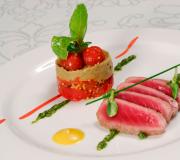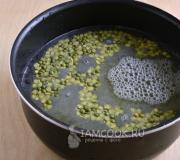Multilayer paper sculptures. Get inspired by ideas for interesting crafts by looking at paper sculptures by Benja Harney
Creating sculptures from the most different materials humanity has been engaged in this since ancient times. There are known products made of stone and horn, made back in the days when people lived in caves and worshiped the forces of nature. Paper is a relatively new material; it became available to the general population quite recently, so it has only recently begun to be used to create works of art.
Previously, paper was only the basis for graphic and paintings, volumetric images of her were rare. In Japan, paper figures were created using the origami technique - by specially folding the sheet, three-dimensional images of various animals and fantastic creatures, flowers and fish. In Europe, paper sculpture was limited to papier-mâché - laying out a three-dimensional object from pieces of soaked, loose paper.
 Paper sculpture "Beavers" by Calvin Nicholls
Paper sculpture "Beavers" by Calvin Nicholls  Paper sculpture "Bear" by Calvin Nicholls
Paper sculpture "Bear" by Calvin Nicholls  Paper sculpture "Owl", Calvin Nicholls
Paper sculpture "Owl", Calvin Nicholls
But true paper sculptures appeared only in the second half of the 20th century. Nowadays, there are already quite a lot of such masters, and paper sculptures have become a full-fledged part of contemporary art. One of famous masters creating their unique works from ordinary paper - Canadian sculptor Calvin Nicholls. He performs to the utmost realistic images plants, birds and animals, using paper, glue and a strong frame to give rigidity and volume to their works. In his sculptural paintings, animals and flowers seem alive and real.

 Paper sculpture "Indians", Patty and Allen Eckman
Paper sculpture "Indians", Patty and Allen Eckman
Married couple Patty and Allen Ekman create incredibly accurate and detailed images of the life of the Cherokee Indians, using several techniques of working with paper. Their multi-figure compositions amaze with their expression and realism.


The sculptor from Beijing Li Hongbo works using a very special technique. He creates sculptural images, which can be stretched and deformed like a spring. This unusual effect is created through a very complex selection and adjustment of hundreds, even thousands of layers of paper, in a special way connected to each other. These unique works of art seem to be made of a dense matte material such as marble, but as soon as you touch them, the entire structure begins to move.

Jeff Nishinaka creates truly epic three-dimensional canvases from paper. Particularly impressive is one painting based on a traditional Asian plot - the battle between the Phoenix and the Dragon. Snake-like Chinese dragon writhes in bizarre rings, and a huge magic bird with wonderful long feathers in the wings and tail. The image consists of many small details, masterfully conveying the pattern of feathers and scales of the characters.


Danish artist Peter Callesen has a completely original style of making paper sculptures. In all his works, a mandatory element is a large sheet of paper on which three-dimensional paper figures are located. The slits on the Whatman paper correspond exactly to the sculptures and depict shadows or the true appearance of an object, such as a building.
I would like to believe that paper works have a great future, because modern sculptors learned to turn it into unique works of art, looking at which you can’t believe that all these perfect creations were created from such a simple and fragile material.
In Japan, paper art such as origami, kirigami and similar sculptures have long been traditional. How they surprise and delight beautiful crafts made of paper arranged in three-dimensional compositions.
Sometimes it can be very difficult, or even impossible, for a non-professional to repeat them even using diagrams and master classes. But if you really want to do something like that, you start looking for compromises. In the current search I came across the author of the paper Benja sculptures Harney. Benja himself successfully applies his favorite hobby in the commercial field, advertising, mass media, so this is not a hobby for him, but a job. Idea of this creativity I really liked it; making a figure this way, in my opinion, is much easier than folding it using the origami technique.

The method is really not that difficult to master. At the graphic design department, we made layouts in this way, while almost no attention was paid to the technology itself. You draw the model, then draw its layout with all sides, leaving bends for fastening and connecting the sides. Remember that we all glued together the same cube or parallelepiped from paper in geometry lessons at school.

In design, more complex figures are glued together in this way, such as building models and other three-dimensional compositions. Of course, three-dimensional vision is very useful in such work, but you can start with simple shapes, gluing them together.

By applying layer after layer of colored paper, the composition becomes multi-level, volume is created, and the figures acquire three-dimensionality.

Benja was fascinated by this process during his studies, still in the same graphic design department, and now very beautiful paper models come out of his hands. They are so interesting and neatly executed that you can’t call them anything other than paper sculpture.

Creation Benja Harney is somewhere on the border between design and art.

His works are original and attract attention. Large brands and famous people are showing interest in them.

For example, Benja made paper wings for the Sydney showcase of the luxury brand Hermes.

For Kylie Minogue's Australian tour, they came up with a pop-up book for her album.

Many people are able to make an ordinary airplane out of paper. This is the most simple thing, which can only be done, and also the simplest and light form paper art. In a sense, it can even be called flying art. However, there are people who have taken it to the next level in . Unfortunately, there are not so many of them.
Such masters can transform the classic form of origami in combination with miniature cutting, bending, in different forms and paper cutting techniques, as well as using quilling, into the most beautiful creative artwork that you have ever seen.
Viewing this article, you'll learn how these artists turn sheets of paper into masterpieces and transform ordinary paper cutting into real art. In addition, you will see all these works with your own eyes. The photo shows paper sculptures that were created by the best paper crafts worldwide.
Jen Stark
Jen Stark - contemporary artist. Most of her works are paper sculptures. She also draws and does animation. Jen draws inspiration for her work from microscopic patterns in nature, wormholes and tissue cross-sections (illustrations in anatomy books).


Up and Out Opposite Coriolis Effect
Simon Schubert
Simon Schubert works and creates in Cologne, Germany. His works are paintings with architectural objects depicted on them. This ordinary situations or objects. Simon Schubert uses white paper And mixed media embossing.



Emma Van List



Daniel Grein
Digital and Print Designer at the University of Applied Sciences, Schwäbisch Gmünd, Germany.


Elodole


Helen Musselwhite



Helen Musselwhite creates unique paper sculptures that you can't take your eyes off. She uses patterns to cut out paper that are significantly different from all the others. Each piece is made up of intricate hand-cut layers of colored paper and interesting graphic paper elements that together create unusual and intriguing scenes in their framed boxes.
Carlos N. Monila


Olafur Eliasson


Jolis Paons
This sculpture is in the form women's dress made from pages of a telephone directory.


Aoyama Hin
“I don't stick to tradition, but I strive to create a mixture of modern and traditional styles and create your own own world using this super thin paper lace technique,” says Aoyama.


Cher Christopher
Cher trained in sculpture at the University of Wolverhampton with a BFA in 3D Design. She successfully passed her final exam at Covent Garden in 1992. Sher works with clay forms and paper.



Yulia Brodskaya
Yulia Brodskaya was born in Moscow. Before moving to the UK in 2004, she was interested in a variety of creative techniques: painting on fabric, origami, collages, as well as traditional art. In her works she often uses the technique quilling.



Not many craftsmen are engaged in this type of creativity today. And very few have achieved success in this field.
Calvin Nicholas
The paper sculpture made by this unique artist is amazing and extremely realistic. In 1981, Calvin opened his own design studio in Toronto. And three years later he made his first experiment, trying to combine his love for wildlife and his craving for creativity. This is how paper sculpture was born.
Calvin Nicholas invented his own method of creating three-dimensional paintings, the subject of which were portraits of animals. First, he creates a rigid paper skeleton of the future object. Then the sculptor attaches it to small parts: feathers, hairs, scales. Each piece is given a special texture using wooden and metal fixtures and tools. Nicholas achieves almost one hundred percent realism when depicting representatives of the animal world.
Paper sculpture by Piret Callesen
The whole world today knows the name of this artist. He creates his own paper sculptures using a combination of cutting and folding. Real masterpieces are obtained literally from a single A4 sheet.

These are incredible plot scenes and individual vivid images. His paintings contain deep meaning, the fragility of the material carries romanticism, emphasizes the tragedy of the sculptures, shows how short-lived happiness is, how fragile human life is.
Wet paper sculptures
Spouses Allen and Patty Eckman developed their own unique technique creating real masterpieces from ordinary waste paper. The paper is deoxidized in a special way and turns into a homogeneous mass. A silicone mold is prepared in advance, into which the material is folded, compacted and then dried.
And here the masters get down to business difficult stage work. Using a medical scalpel, the artists work out every smallest detail, every fold and hair, giving the sculpture amazing vitality and truthfulness.
It takes craftsmen more than a year to create one masterpiece. After all, first you need to fashion a sculpture from plasticine or clay. Then a silicone mold is made from it to cast the workpiece. And that's just preparatory stage to work.

Of course, the most difficult thing is to remove everything unnecessary with precise movements. Even the smallest mistake in work can nullify all previous work, no matter how long and painstaking it may be.
Paper sculptures at home
Looking at the works of great masters, it seems that this is impossible to an ordinary person. However, it is possible to try to do something similar. Let it turn out not so highly artistically, not so masterfully, but from the heart.
So how to make a paper sculpture yourself?
- First you need to sculpt the figure you want to create from plasticine.
- The template is then covered with layers of silicone sealant. The total thickness of the mold must be at least 3 cm. The procedure is performed in two stages: the first layer must carefully fill all small recesses and crevices, after drying, the second layer directly creates the thickness of the future mold. Then you need to let the form dry thoroughly.
- After all this, the workpiece is carefully cut and the plasticine is removed.
- Now the paper pulp is prepared, with which the form is filled.
- After drying, the workpiece is removed and processed with a sharp scalpel.
- If necessary, paint or varnish is applied to the sculpture.
There are many recipes for creating paper pulp. The simplest one is that the paper is thoroughly soaked and crushed, squeezed out, a little sifted wood ash or gypsum is added to it and kneaded like dough.

From such a mass one can not only cast sculptures, but also sculpt them, as craftsmen do when working with clay and other materials.
Original creativity Patty and Allen Eckman.
Artists first mix acid-free cellulose using raw cotton, all of which is placed in a mold, compressed by vacuum or by hand. In this case, excess moisture is gradually removed, but the drying process is very long. When the cast is removed from the mold, then the finishing process begins, the most delicate one. Some details are removed, some are added, which ensures very fine detailing.
(MODULE=240&style=margin:20px;float:left;)
This is very Long procces, sometimes taking months of work. In some ways it is similar to the bronze casting process. Finished product - white, very light and with many fine details.
(MODULE=241&style=margin:20px;float:left;)
Paper sculptures by Calvin Nicholls. Animalism in sculpture
Calvin Nicholls – unique artist and sculptor. His sculptures (which can be called three-dimensional paintings) are created from paper that is common to us. Paper cut and glued in a special way creates amazing detail in the works. Calvin mostly creates paper portraits of wild animals - bears, lynxes, monkeys, birds and others.
Each voluminous creation takes a lot of time and painstaking work. The first step is to create a rigid skeleton, which is the outline of the future figure. The frame gives the work strength. All other small parts are already attached to the frame. Each piece is cut and textured using a selection of metal and wooden instruments. During the work process, the sculptor constantly monitors the light and shadow on the sculpture. Having completed the main part of the work, the author creates an even more detailed and complex image using studio lighting. At this stage of work, all the nuances of the sculpture are completed.
And finally – photography.

(MODULE=242&style=margin:20px;float:left;)





Peter Callesen sculptures from a single A4 sheet
Danish-born artist Peter Callesen creates incredible works of art from a single A4 sheet of paper. Through a surprising combination of cutting and folding, Callesen creates incredible scenes from the very simple material.
According to him in my own words By eliminating all the information and starting from scratch on a blank white A4 sheet, he feels that he has found material that everyone can relate to. At the same time, the A4 sheet is neutral and open to accept any meaning. The thinness gives the paper sculptures a fragility that highlights the tragic and romantic theme of his sculptures.







Jeff Nishinaka. Paper sculpture
Jeff says that he will always become an artist, the most an ordinary artist, but over time he realized that he did not have the necessary abilities and talent. He started working with paper by accident. During his studies, he was given assignments in two subjects: graphic design and according to the drawing. The task was to create something new from some material. He chose paper. And this choice, the art of creating paper sculptures, gave him a sense of what his calling was, in what area he needed to work. He was attracted by the clear boundaries in working with paper and tangible results. And he always took pleasure in creating something with his own hands.




